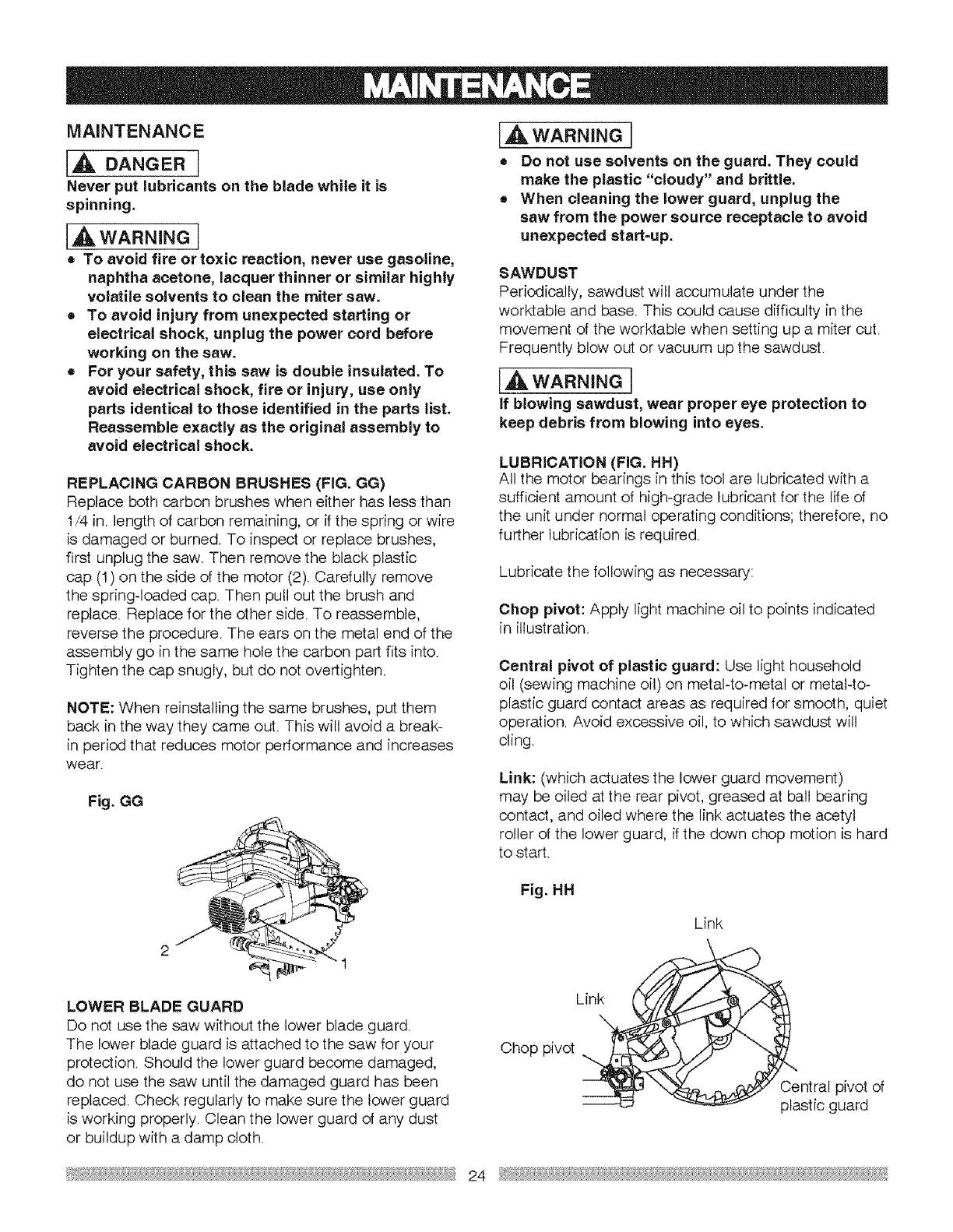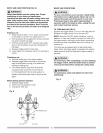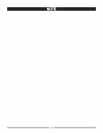
MAINTENANCE
[,_ DANGER
Never put lubricants on the blade while it is
spinning.
[A WAR.. GI
• To avoid fire or toxic reaction, never use gasoline,
naphtha acetone, lacquer thinner or similar highly
volatile solvents to clean the miter saw.
• To avoid injury from unexpected starting or
electrical shock, unplug the power cord before
working on the saw.
• For your safety, this saw is double insulated. To
avoid electrical shock, fire or injury, use only
parts identical to those identified in the parts list.
Reassemble exactly as the original assembly to
avoid electrical shock.
REPLACING CARBON BRUSHES (FIG. GG)
Replace both carbon brushes when either has less than
I/4 in. length of carbon remaining, or ff the spring or wire
is damaged or burned. To inspect or replace brushes,
first unplug the saw. Then remove the black plastic
cap (I) on the side of the motor (2). Carefully remove
the spring-loaded cap. Then pull out the brush and
replace. Replace for the other side. To reassemble,
reverse the procedure. The ears on the metal end of the
assembly go in the same hole the carbon part fits into.
Tighten the cap snugly, but do not overtighten.
NOTE: When reinstalling the same brushes, put them
back in the way they came out. This will avoid a break-
in period that reduces motor performance and increases
wear.
Fig. GG
LOWER BLADE GUARD
Do not use the saw without the lower blade guard.
The lower blade guard is attached to the saw for your
protection. Should the lower guard become damaged,
do not use the saw until the damaged guard has been
replaced. Check regularly to make sure the lower guard
is working properly. Clean the lower guard of any dust
or buildup with a damp cloth.
[AWAR"m"G]
= Do not use solvents on the guard. They could
make the plastic "cloudy" and brittle.
• When cleaning the lower guard, unplug the
saw from the power source receptacle to avoid
unexpected start-up.
SAWDUST
Periodically, sawdust will accumulate under the
worktable and base. This could cause difficulty in the
movement of the worktable when setting up a miter cut.
Frequently blow out or vacuum up the sawdust.
IAwAR"'JGI
if blowing sawdust, wear proper eye protection to
keep debris from blowing into eyes.
LUBRICATION (FIG. HH)
All the motor bearings in this tool are lubricated with a
sufficient amount of high-grade lubricant for the life of
the unit under normal operating conditions; therefore, no
further lubrication is required.
Lubricate the following as necessary:
Chop pivot: Apply light machine oil to points indicated
in illustration.
Central pivot of plastic guard: Use light household
oil (sewing machine oil) on metal-to-metal or metal-to-
plastic guard contact areas as required for smooth, quiet
operation. Avoid excessive oil, to which sawdust will
cling.
Link: (which actuates the lower guard movement)
may be oiled at the rear pivot, greased at bal! bearing
contact, and oiled where the link actuates the acetyl
roller of the lower guard, if the down chop motion is hard
to start.
Fig. HH
Link
Chop pivot
Link
_ntral pivot of
stic guard
24


















